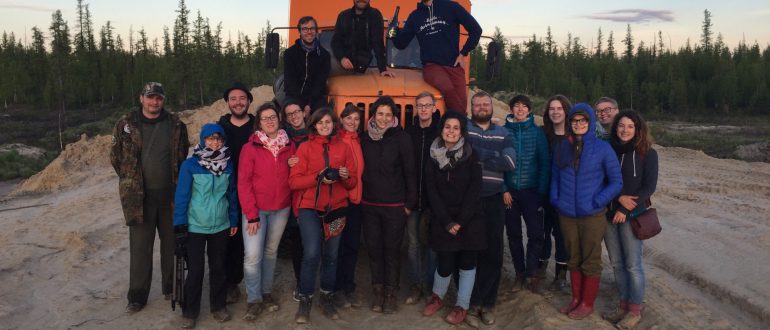
A White Night in the Tundra: Snapshots from Nadym and Surroundings
Visiting two former labour camps along the 501 Railroad, more commonly (together with Railroad 503) known as the Transpolar Mainline, Dead Road or Stalinbahn, was for many in the group the absolute highlight of our trip and a top priority that not even a force majeure could prevent us from seeing. In fact, when on the night train from Surgut to Novy Urengoy voices started spreading about a potential cancellation of our visit to the camps due to road construction works, the devising of alternative strategies and innovative proposals (ok, and a couple of beers as well) kept some of us awake deep into the night. The winning solution somehow self-imposed itself, considering the information that had reached us by that time: the road would be opened at 6 am and then again at 6 pm. No, dear reader, our decision was not to spend a whole day in the tundra wilderness, but to take advantage of Siberian white nights instead. However, before we delve deeper into the forest, let us first devote a couple of lines to the warm welcome we received at the Arctic Research Centre in Nadym. This is also where we worked in groups and come up with the first rough outlines of what you will read about in our flyer (link). The researchers at the Centre not only gave us an introduction on the Construction 501 camps we would later see, but also acquainted us with many of the cosmetic and alimentary products they derive chiefly from reindeer moss and other medicinal plants retrievable in the Arctic.
In the city itself, we visited the Museum of History and Archaeology of Nadym-House of Nature, which among its zoological, paleontological and ethnographic collections also hosts a permanent exhibition on Construction 501.
After having amazed the museum docent with our knowledge and interest on the topic, we split into smaller groups and explored Nadym, «the mossy place»: some went to a Russian style spa, the banya, others played football with the local kids, went hunting for monuments or were desperately looking for postcards…The bottom line is: we all met in a lovely Uzbek restaurant half way between the city centre and the airoport (yes, Nadym has one), where our hotel was located.
The long-awaited trip to the camps took place on one of the two nights or extremely long days spent in Nadym. First we drove with a lovely, small vehicle to the farthest point reachable by car and then for obvious reasons (see picture below) continued on foot.
The first camp we visited, at the crossing loop Schuchiy, is closer to the main road and thus more accessible for visits, which is why it displayed larger evidence of previous visitors’ presence. In the absence of a more «institutionalized» way of remembering the inmates, coins, cigarettes, an icon, but also a portrait of Stalin (!) were left by visitors.
We then continued walking along the abandoned railway in order to reach the camp at the crossing loop Glukharinyy, accompanied by three locals who were selflessly taking care of us and helping us to cross the more demanding, swampy and overgrown parts of the path.
The state of affairs on the site of the two camps made us think about the dynamics of top-down and bottom-up memory, as well as on the plurality of memory narratives: how the GULAG is remembered today by various actors, including the survivors and their families, the State, non-governmental organisations? How is the memory of the GULAG preserved and transmitted to future generations?
Shortly after the road reopened, full of impressions we went back to the hotel to rest a bit before continuing our exploration of the Yamalo-Nenets Autonomous Okrug in the gas capital of Russia, Novy Urengoy.
This article was published as part of IFAIR’s ‘Memory as a tool of change – Forgotten Places in Siberia’ Impact Group.
